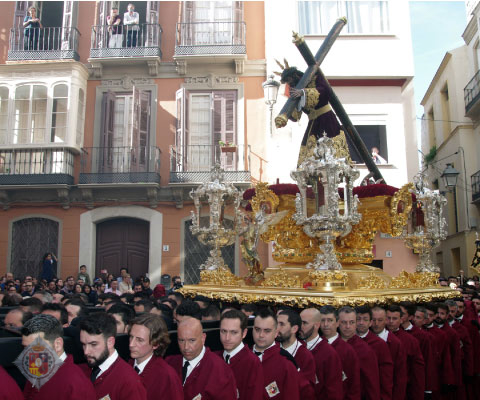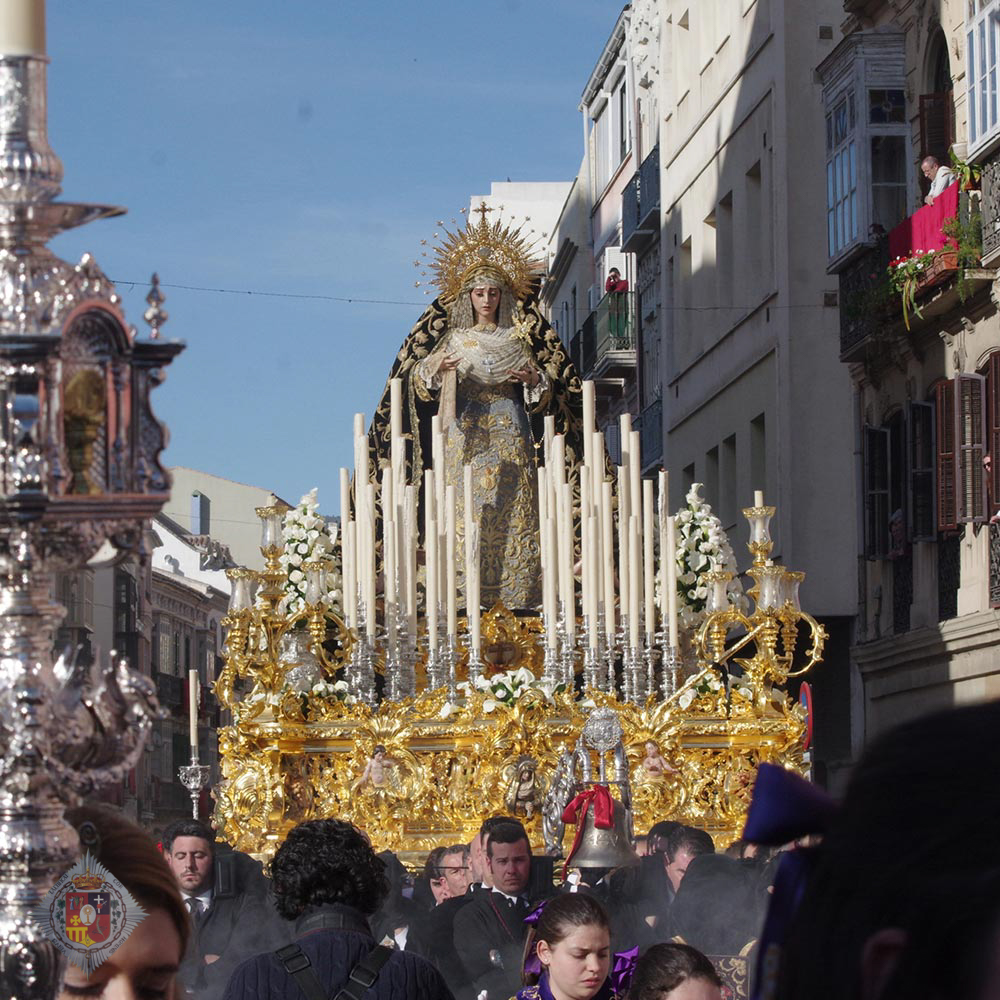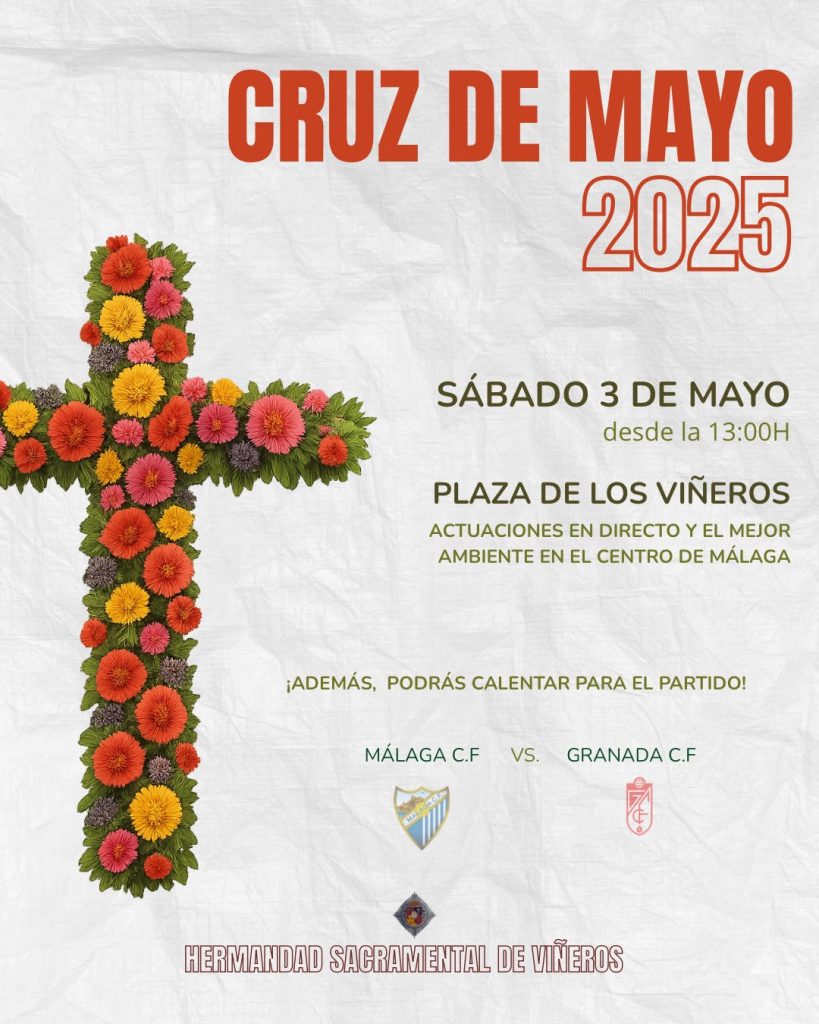ALTAR MAYOR
Constituido por un retablo tipo camarín que data del siglo XVIII, restaurado por Cristóbal Velasco en el año 1951, estando presidido por la imagen del Nazareno de Viñeros.
Está presidido en su parte central superior por el símbolo mariano que representa la procesión de la fe hacia la Virgen María y sus glorias.
En el centro del retablo se representa la Divina Providencia que es el concepto religioso por el cual una divinidad crea e influye en el universo, en especial la Tierra para el socorro de la humanidad. Es el dogma del teísmo. El poder de Dios sobre las leyes de la naturaleza para así cumplir su cometido, gobernar y preservar el mundo para llevar a cabo su voluntad.
En el lado derecho se ve representada la pasión de Cristo con la columna y los azotes, y en el lado izquierdo, la muerte de Cristo.
A los pies de la Divina Providencia se hace referencia a la orden dominica.
En el altar mayor encontramos a ambos lados a San José y a San Lorenzo Mártir.
Los vinateros se reúnen el día de San José en 1615. Como guiño a este acto tan importante se representó a San José en el retablo del Altar Mayor de la iglesia. La Hermandad de Viñeros tiene establecido como fecha de realización del Triduo del Señor próximo a esa fecha.
San Lorenzo fue un sacerdote español, durante toda su vida religiosa administró los bienes de la Iglesia. Fue uno de los mártires ajusticiados junto al papa Sixto II durante la persecución Cristiana del emperador Valeriano, el cual solicitó a Lorenzo los tesoros de la Iglesia. Lorenzo le pidió al emperador que le diera tres días para reunir todos los tesoros que exigía. El sacerdote desobedeciendo la orden del emperador, en vez de entregar todos los tesoros que le solicitaba del templo, los enterró. Lorenzo reunió a los pobres, ancianos y enfermos, para presentarlos como el tesoro más preciado. Ante la desobediencia, el Rey lo mandó a matar, condenándolo a morir en una parrilla ardiente. Se cuenta que San Lorenzo dijo mientras se encontraba en la parrilla que ya, quemado por un lado del cuerpo, le diesen la vuelta para que se quemase por el otro (al igual que la pasa).
NAZARENO DE VIÑEROS
Obra de estilo neobarroco de talla completa. Con encarnadura en cabeza, pies y manos. La efigie al desnudo presenta pureza de talla dónde está estampada la firma del artista al igual que bajo la peana.
Representa a Jesús en el momento de ser cargado con la cruz sobre el hombro izquierdo en actitud de caminar como se aprecia en la postura de los pies, donde el talón izquierdo esta elevado de forma valiente, poniendo de manifiesto el gran esfuerzo que se distribuye por toda la anatomía.
Esta talla es la tercera que recibe la advocación de Nazareno de Viñeros, siendo la primera, de autor anónimo, la existente en la fundación de la Hermandad en 1615, y que fue tristemente destruida en la quema de conventos de 1931, en la que ardió nuestra sede en aquel entonces, la desaparecida Iglesia de la Merced.
Más tarde se encargó una segunda talla al imaginero malagueño Adrián Risueño, la cual procesionó desde la reorganización de la Hermandad, saliendo por vez primera en 1949, hasta el año 1975, en el que fue sustituida debido a distintos daños estructurales sufridos. El busto de dicha talla recibe aún culto interno en nuestras dependencias.
HIGH ALTAR
Built of a chapel-type altarpiece from the 18th century, restored by Cristóbal Velasco in 1951, it is presided over by the image of the Nazareno de Viñeros.
In the upper central zone, on the one hand, we visualize the Marian symbol that represents the procession of faith towards the Virgin Mary and her glories. On the other hand, Divine Providence is represented as the religious concept by which a divinity creates and influences the universe.
On the right side, the passion of Christ is represented with the column and the whipping; on the left, the death of Christ. At the feet of Divine Providence reference is made to the Dominican order.
On the main altar we find San José and San Lorenzo Mártir on both sides. The vintners meet on Saint Joseph’s Day in 1615, which is why it is represented in homage to Saint Joseph in the altarpiece of the High Altar of the Church and consequently, it is the date established in our brotherhood for the realization of the Triduum of the Lord.
San Lorenzo was a Spanish priest, one of the martyrs executed along with Pope Sixtus II during the Christian persecution of Emperor Valerian, who asked Lorenzo for the treasures of the church. Throughout his religious life he administered the assets of the Church. Lorenzo asked the emperor to give him three days to collect all the treasures he demanded. The priest disobeyed the order of the emperor, instead of delivering all the treasures that he requested, he buried them, and gathered the poor, old and sick, to present them as the most precious treasure. Given the disobedience, the King ordered to execute him, condemning him to die on a burning grill. It is said that San Lorenzo said while he was on the grill that he had already been burned on one side of his body, so they would turn him over so that he could burn on the other (just like it happens).
NAZARENO DE VIÑEROS
Full-size neo-baroque style work, with incarnation on the head, feet and hands. The naked effigy presents purity, it has the artist’s signature stamped on it, just like on his base.
It represents Jesus carrying the cross on his left shoulder walking just as he appears in the posture of his feet, where the left heel is courageously raised, revealing the great effort that is distributed throughout the anatomy.
This carving is the third to receive the dedication of Nazareno de Viñeros, being the first, by an anonymous author, whose few remains are discussed due to the burning of convents in 1931, in which our headquarters burned at that time, the disappeared Church of Mercy.
Subsequently, a second carving was commissioned from Málaga image maker Adrián Risueño, who it has been in procession since the reorganization of the Brotherhood, coming out for the first time in 1949 until 1975, when it was replaced due to various structural damages. The bust of this size still receives internal worship in our dependencies













